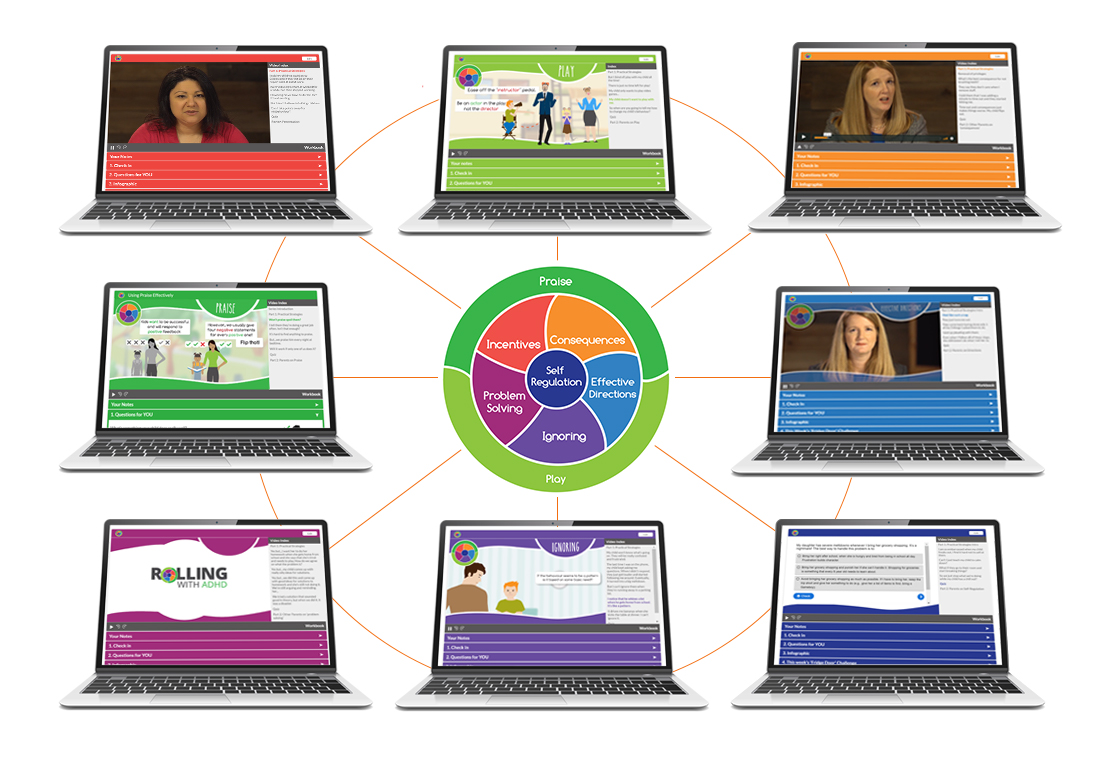
The task
To make an online version of a successful Rolling with ADHD course for parents of children with ADHD, delivered by BC Children’s Hospital. The original ask was that the course would be delivered via a WordPress LMS.
Target Audience
Tired parents of demanding children! Basically we were competing with Netflix in the ‘kids-finally-asleep’ zone. Yet another login to remember and a navigational learning curve through yet another platform were defined as definite barriers to entry and involvement.
Solution: Sidestep the LMS!
Being a public health initiative, the course is free so no pay wall is needed, and no precise compliance metrics needed beyond generic, non-individualized course take up, progress and completion, where simple analytics and Vimeo video stats suffice.
So our suggestion was to sidestep an LMS entirely. This removes the login and platform barriers for take up and also means that no personal user course interactions – notes, plans, reflections, quiz answers – are stored on any database.
So a large privacy headache removed.
Refocusing on the Lesson
 Instead of logging on, learners link to the course via a series of timed emails, one-a-week for eight weeks from the moment they sign up. The email gives a teaser for the lesson and links the learner through to a public page with a lesson created and delivered with the Learnbase Video Lesson Maker. The Lesson Maker enables the authoring of complex interactive lessons and can be added via simple shortcode to any WordPress page, post or LMS lesson entry. It provides a sophisticated lesson flow with interactive video and a personalized workbook section – essentially a module on a single page.
Instead of logging on, learners link to the course via a series of timed emails, one-a-week for eight weeks from the moment they sign up. The email gives a teaser for the lesson and links the learner through to a public page with a lesson created and delivered with the Learnbase Video Lesson Maker. The Lesson Maker enables the authoring of complex interactive lessons and can be added via simple shortcode to any WordPress page, post or LMS lesson entry. It provides a sophisticated lesson flow with interactive video and a personalized workbook section – essentially a module on a single page.
Normally, when a user is logged-in, all the workbook entries are saved to database so they are still there to be added to upon return and can also be downloaded as a PDF along with the other learning content of the workbook.
The great thing here is that we also made it work almost identically for anonymous users.
Privacy: using the browser not database
When a lesson is loaded in a public page, a user can still use the workbook, create notes that will reappear when they return to the page and download their notes when ready. In this case however the notes save to their browser not the Health Authority database. This is different and deeper to mere browser caching and so the notes are not lost if the learner clears their cache.
The notes are therefore only available on a single browser and while learners can view the lesson from any device, we recommend they select a single device for their notes and reflections. This maximizes privacy, and we also give them a big easy ‘delete notes’ button so notes can be wiped from their browser memory easily.
So the only personal data is the users name and email when they sign up. After that it is an entirely private experience for the learner.
Borrowing the landing page approach
We borrowed techniques from the slightly dark side of list-building coaching ‘courses’ where there is as little as possible to distract the user away from an intended journey to sign up with clear, minimal calls to action. It works, so why not use it for good!?
Therefore all the Rolling with ADHD pages are made in the landing page style. All general site navigation / menus / headers are hidden and only the essential links visible. This way we can have multiple but entirely siloed course destinations on a single client site with a simple, directed user experience and specialized branding for each course.
Check out a module: (no need to log in, right):
Module 1: https://healthymindslearning.ca/rollingwith-adhd-module-1-using-praise-effectively/
The course landing page: https://healthymindslearning.ca/rollingwith-adhd/